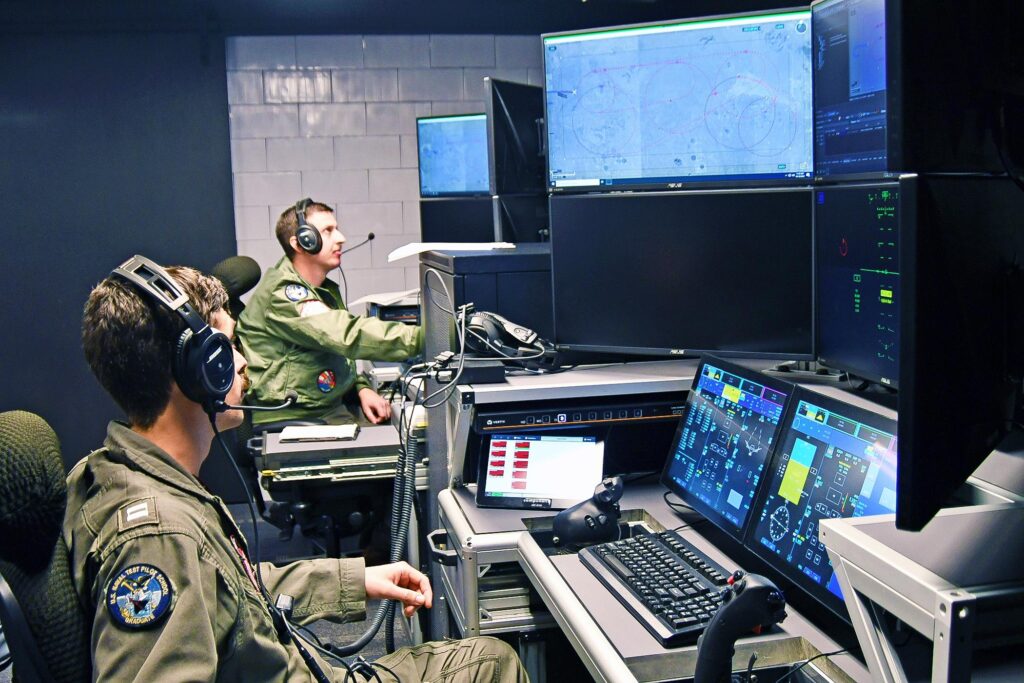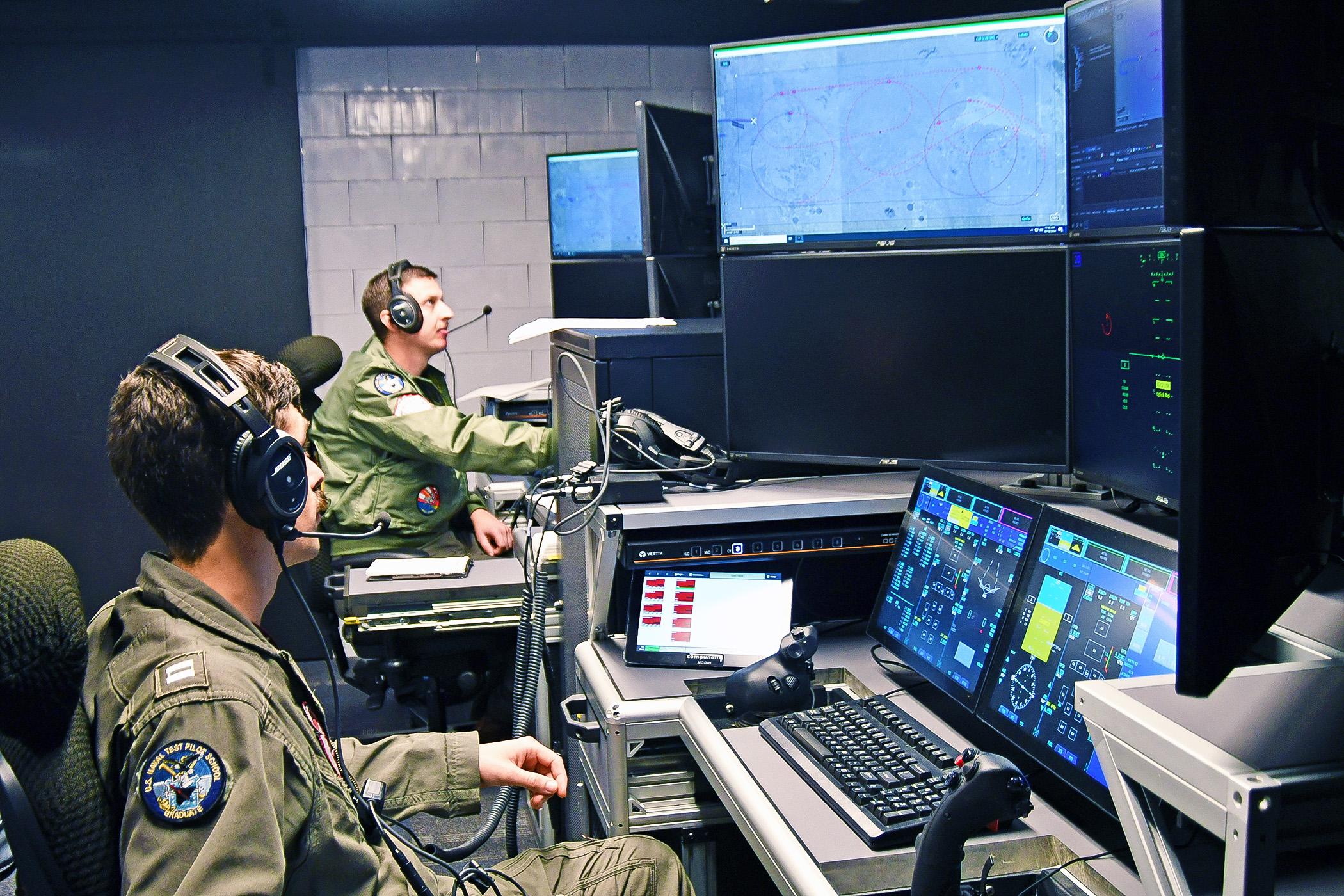Navy Works With General Atomics And Lockheed Martin To Demonstrate Drone Control Station


MQ-25 Air Vehicle Pilots Lt. Matt Pence (forward) and Lt. Steven Wilster conduct a test run to monitor the Unmanned Carrier Aviation Mission Control System ground control station, located at Naval Air Station Patuxent River, Md., as the system commands the General Atomics Aeronautical Systems, Inc. (GA-ASI) MQ-20 Avenger surrogate, located at the company’s test facility in California, in preparation for demonstration event in November 2024. (Photo: U.S. Navy)
The Navy tested command and control of an unmanned aircraft using its Unmanned Carrier Aviation Mission Control Station (UMCS) for the first time this week in a demo using the General Atomics Aeronautical Systems, Inc. (GA-ASI) MQ-20 Avenger and Lockheed Martin software.
Naval Air Systems Command (NAVAIR) said GA-ASI initiated this joint demonstration that on Nov. 5 had the Unmanned Carrier Aviation program office PMA-268 use its UMCS with the MD-5 Ground Control Station (GCS), loaded with the Lockheed Martin Skunk Works MDCX platform, command and control the GA MQ-20 Avenger.
GA said the MQ-20 technology demonstrator acted as a surrogate to demonstrate how the Navy’s Unmanned Carrier Aviation Mission Control Station (UMCS) can command various unmanned aircraft with autonomous maneuvers. The Navy noted this proves the UMCS can command other aircraft beyond the under-development MQ-25 carrier-based unmanned tanker aircraft.
Navy operators used an MD-5 Ground Control Station (GCS) out of the Navy’s Patuxent River, Md., test facility to command and control the MQ-20 flown out of GA-ASI’s Desert Horizon flight operations facility in El Mirage, Calif.
The team was able to operate over this large distance by using an unspecified proliferated Low Earth Orbit (pLEO) satellite constellation datalink.
NAVAIR said it will use the data from this demonstration to refine program requirements and develop more key technologies. The team plans to conduct more digital and live surrogate test flights to demonstrate various aspects of CCAs including autonomy, mission systems, crewed-uncrewed teaming, advanced communications and more command and control development.
Lockheed Martin boasted its Skunk Works MDCX autonomy platform enabled the Navy air vehicle pilots to control the MQ-20 during its California flight.
NAVAIR describes the UMCS as a system-of-systems required for MQ-25 command and control that should apply to other Navy unmanned aircraft control in the future.
GA underscored this was the first time any General Atomics UAS conducted bi-directional communications using the UMCS operation codes while also performing autonomous behavior, using the pLEO datalink.
“UMCS is laying a foundation that will enable control of all unmanned carrier aircraft, starting with the MQ-25 aircraft. The UMCS opens the door for efficiently introducing future unmanned systems into the complex carrier command and control architecture,” Capt. Daniel Fucito, PMA-268 program manager, said in a statement.
“This was a huge step for unmanned naval aviation. This demo showcased UMCS’s first live control of an unmanned air vehicle, and it was great to be part of history in the making. The team is paving the way for integrating critical unmanned capability across the joint force to combat the high-end threat our warfighters face today and in the future,” Lt. Steven Wilster, MQ-25 AVP, added.
General Atomics characterized this demonstration as part of the overall effort to move technology forward for the future Collaborative Combat Aircraft (CCA), for which the Navy and Air Force intend future manned fighters to command several unmanned wingmen to perform missions.
The Navy, Marine Corps and Air Force are collaborating under a Tri-service Memorandum of Understanding for critical subsystems for CCAs, with the Navy leading development of a common control architecture and GCS, in collaboration with Lockheed Martin.
GA-ASI said the MQ-20 is being used “extensively” as a surrogate CCA testbed for autonomous technology development.
In April, the Air Force downselected to GA and Anduril for CCA testing, with them both set to move forward on detailed designs, manufacture and testing of production-representative test articles for the CCA program.
“This effort was a prime example of industry partners and government agencies working together to perform important new capabilities. The team efficiently and safely demonstrated aircraft flight control from another government agency’s control station. Using GA-ASI’s Tactical Autonomy Core Ecosystem (TacACE) software, the team not only executed airborne commands, but did so in a safe, controlled environment,” GA-ASI president David Alexander, said in a statement.
John Clark, vice president and general manager at Lockheed Martin Skunk Works, said they are happy to collaborate with the Navy to help move toward its air wing of the future vision.
“The MDCX made it possible to rapidly integrate the MQ-20 ‘autonomy core’ with the UMCS, demonstrating common control capability and third-party platform integration,” Clark said in a statement.
A version of this story originally appeared in affiliate publication Defense Daily.
The post Navy Works With General Atomics And Lockheed Martin To Demonstrate Drone Control Station appeared first on Avionics International.
—————
Boost Internet Speed–
Free Business Hosting–
Free Email Account–
Dropcatch–
Free Secure Email–
Secure Email–
Cheap VOIP Calls–
Free Hosting–
Boost Inflight Wifi–
Premium Domains–
Free Domains





